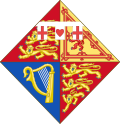By birthright
| Place in line of succession | Image | Name | Arms | Age | Royal lineage | Spouse |
|---|---|---|---|---|---|---|
| Descendants of Charles III | ||||||
| 1 |  | William, Prince of Wales |  | 43 | Son | Catherine Middleton |
| 2 |  | Prince George of Wales | 12 | Grandchild | — | |
| 3 |  | Princess Charlotte of Wales | 10 | |||
| 4 |  | Prince Louis of Wales | 7 | |||
| 5 |  | Prince Harry, Duke of Sussex |  | 41 | Son | Meghan Markle |
| 6 |  | Prince Archie of Sussex | 6 | Grandchild | — | |
| 7 |  | Princess Lilibet of Sussex | 4 | |||
| Descendants of Elizabeth II | ||||||
| 9 |  | Princess Beatrice, Mrs Edoardo Mapelli Mozzi |  | 37 | Grandchild | Edoardo Mapelli Mozzi |
| 12 |  | Princess Eugenie, Mrs Jack Brooksbank |  | 35 | Jack Brooksbank | |
| 15 |  | Prince Edward, Duke of Edinburgh |  | 61 | Son | Sophie Rhys-Jones |
| 16 |  | James Mountbatten-Windsor, Earl of Wessex [a] | 17 | Grandchild | — | |
| 17 |  | Lady Louise Mountbatten-Windsor [b] | 22 | |||
| 18 |  | Anne, Princess Royal |  | 75 | Daughter | Timothy Laurence |
| Descendants of George V | ||||||
| 32 |  | Prince Richard, Duke of Gloucester |  | 81 | Grandchild | Birgitte van Deurs Henriksen |
| 42 |  | Prince Edward, Duke of Kent |  | 90 | ||
| 53 |  | Prince Michael of Kent |  | 83 | Baroness Marie-Christine von Reibnitz | |
| 58 |  | Princess Alexandra, The Honourable Lady Ogilvy |  | 88 | ||









